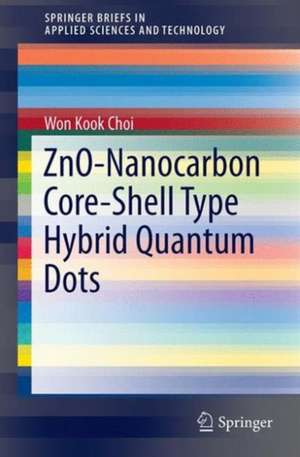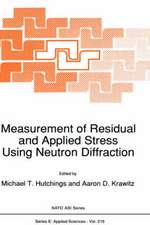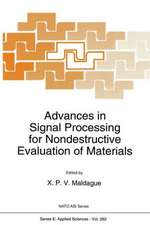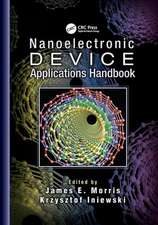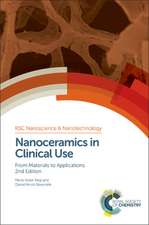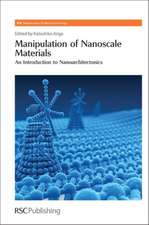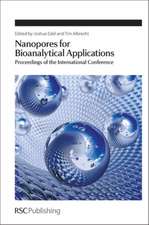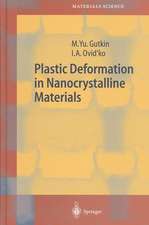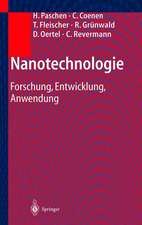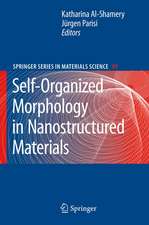ZnO-Nanocarbon Core-Shell Type Hybrid Quantum Dots: SpringerBriefs in Applied Sciences and Technology
Autor Won Kook Choien Limba Engleză Paperback – 30 aug 2016
The book describes how strong anchoring bonds between a ZnO core and carbon nanomaterial shell will ultimately prevail over the main drawbacks of ZnO with high charge recombination and poor electrochemical stability in liquid solutions. Due to the moderate energy states and excellent electric properties of the nanocarbons, ultrafast charge carrier transport from the ZnO core to the nanocarbon shell is guaranteed with the use of thephotoluminescence (PL) lifetime measurement.
Given the growing interest and significance of future research in optoelectronic and electrochemical devices applications, the contents are very timely. This book is targeted towards researchers looking for highly efficient metal oxide-nanocarbon hybrid functional materials in the fields of nano-optoelectronics, photoelectrochemistry, energy storage and conversion.
Din seria SpringerBriefs in Applied Sciences and Technology
-
 Preț: 380.29 lei
Preț: 380.29 lei - 17%
 Preț: 360.34 lei
Preț: 360.34 lei - 20%
 Preț: 386.12 lei
Preț: 386.12 lei -
 Preț: 380.07 lei
Preț: 380.07 lei -
 Preț: 377.95 lei
Preț: 377.95 lei -
 Preț: 382.32 lei
Preț: 382.32 lei -
 Preț: 376.59 lei
Preț: 376.59 lei -
 Preț: 379.09 lei
Preț: 379.09 lei -
 Preț: 378.12 lei
Preț: 378.12 lei - 20%
 Preț: 293.83 lei
Preț: 293.83 lei -
 Preț: 344.90 lei
Preț: 344.90 lei -
 Preț: 321.36 lei
Preț: 321.36 lei -
 Preț: 264.79 lei
Preț: 264.79 lei -
 Preț: 344.90 lei
Preț: 344.90 lei -
 Preț: 356.46 lei
Preț: 356.46 lei -
 Preț: 382.95 lei
Preț: 382.95 lei -
 Preț: 355.66 lei
Preț: 355.66 lei -
 Preț: 479.67 lei
Preț: 479.67 lei -
 Preț: 415.18 lei
Preț: 415.18 lei -
 Preț: 444.52 lei
Preț: 444.52 lei - 20%
 Preț: 301.86 lei
Preț: 301.86 lei -
 Preț: 409.43 lei
Preț: 409.43 lei - 20%
 Preț: 322.17 lei
Preț: 322.17 lei -
 Preț: 355.49 lei
Preț: 355.49 lei - 15%
 Preț: 462.51 lei
Preț: 462.51 lei -
 Preț: 377.18 lei
Preț: 377.18 lei -
 Preț: 355.93 lei
Preț: 355.93 lei -
 Preț: 382.95 lei
Preț: 382.95 lei -
 Preț: 378.12 lei
Preț: 378.12 lei -
 Preț: 378.12 lei
Preț: 378.12 lei -
 Preț: 380.07 lei
Preț: 380.07 lei -
 Preț: 380.07 lei
Preț: 380.07 lei - 20%
 Preț: 326.28 lei
Preț: 326.28 lei -
 Preț: 312.68 lei
Preț: 312.68 lei -
 Preț: 356.43 lei
Preț: 356.43 lei -
 Preț: 412.30 lei
Preț: 412.30 lei - 20%
 Preț: 225.31 lei
Preț: 225.31 lei -
 Preț: 378.12 lei
Preț: 378.12 lei -
 Preț: 376.59 lei
Preț: 376.59 lei -
 Preț: 195.87 lei
Preț: 195.87 lei -
 Preț: 376.22 lei
Preț: 376.22 lei - 20%
 Preț: 324.64 lei
Preț: 324.64 lei - 20%
 Preț: 288.73 lei
Preț: 288.73 lei -
 Preț: 377.57 lei
Preț: 377.57 lei -
 Preț: 261.91 lei
Preț: 261.91 lei -
 Preț: 381.98 lei
Preț: 381.98 lei -
 Preț: 273.64 lei
Preț: 273.64 lei -
 Preț: 410.87 lei
Preț: 410.87 lei -
 Preț: 379.68 lei
Preț: 379.68 lei -
 Preț: 374.30 lei
Preț: 374.30 lei
Preț: 345.69 lei
Nou
Puncte Express: 519
Preț estimativ în valută:
66.17€ • 71.90$ • 55.62£
66.17€ • 71.90$ • 55.62£
Carte tipărită la comandă
Livrare economică 17-23 aprilie
Preluare comenzi: 021 569.72.76
Specificații
ISBN-13: 9789811009792
ISBN-10: 9811009791
Pagini: 71
Ilustrații: X, 75 p. 55 illus., 47 illus. in color.
Dimensiuni: 155 x 235 mm
Ediția:1st ed. 2017
Editura: Springer Nature Singapore
Colecția Springer
Seriile SpringerBriefs in Applied Sciences and Technology, Nanoscience and Nanotechnology
Locul publicării:Singapore, Singapore
ISBN-10: 9811009791
Pagini: 71
Ilustrații: X, 75 p. 55 illus., 47 illus. in color.
Dimensiuni: 155 x 235 mm
Ediția:1st ed. 2017
Editura: Springer Nature Singapore
Colecția Springer
Seriile SpringerBriefs in Applied Sciences and Technology, Nanoscience and Nanotechnology
Locul publicării:Singapore, Singapore
Cuprins
1 Introduction.- 2 ZnO-Nanocarbon Core-Shell Hybrid Quantum Dots.- 3 Applications of ZnO-Nanocarbon Core-Shell Hybrid Quantum Dots.
Notă biografică
Won Kook Choi received the BS(1984), MS(1986), and Ph.D degree in physics from Yonsei University Korea, in 1993. After that, he joined in Department of Physics, University of Oregon, USA(1993-1994) and Korea Institute of Science and Technology (KIST) as a post-doc in Ceramics Division during 1994-1996. Afterwards he has been worked as a senior and principal research scientist in Thin Film Technology Research Center, Materials Research Division, KIST. During 2012. Feb-2014. Aug, he worked as a head of center in Interface Control Research Center. Since Aug. 2014, he has worked as a director in Materials and Life Science Research Division. He has worked as a professor in Department of Nanomaterials and Nanoscience, Korea University of Science and Technology (KUST). His main research fields are solid surface phenomenon, surface electronic structure study using angle-resolved ultraviolet spectroscopy, and plasma/ion beam surface modification. Since 1998, his research interest was paid on II-VI ZnO semiconductor and LED. In 2008, he reported p-Cu: ZnO/n-SiC heterojunction ZnO-LED emitted cyan-blue color. Recently his group, SNEL (Soft Nano Electronics Laboratory) investigate semiconductor nanoelectronics related to II-VI semiconductor, quantum dot, and van der Waals 2D materials. In 2012, he firstly reported the synthesis of ZnO-graphene core-shell type hybrid quantum dots and realize the emissive ZnO-graphene quantum dot white light-emitting QDLED. Moreover, recently SNEL reported 2D black phosphorous (BP) sheets-based pulsed laser, nonvolatile ferroelectric memory, and charge injection memory.
Caracteristici
Provides an introduction to synthetic processing, chemical and structural analysis of eco-friendly ZnO nanocarbon (C60, Single-Walled CNT, Graphene) core-shell hybrid quantum dots Describes the physical and chemical superiority of ZnO-nanocarbon hybrid materials Covers five examples of applications for high performance ZnO-nanocarbons to light-emitting diodes, photovoltaics, piezoelectrics, and photoelectrochemical devices Includes supplementary material: sn.pub/extras
